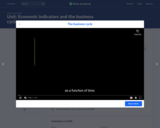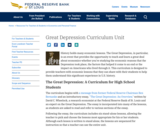
Definition, description, and examples of business cycles in the economy.
- Subject:
- Social Studies
- Material Type:
- Reading
- Provider:
- Library of Economics and Liberty
- Date Added:
- 12/01/2023

Definition, description, and examples of business cycles in the economy.

What are some of the consequences of unemployment, both socially and otherwise? Students will get the answer to this question in the short module, Consequences of Unemployment. This content from Econ Lowdown also features alignment to national Financial Literacy and/or Economics standards.

This 11 minute video examines the parts of the business cycle and what factors contribute to its fluctuation. This video will aid in mastery of standard EPF. 5(c)
Khan Academy learning modules include a Community space where users can ask questions and seek help from community members. Educators should consult with their Technology administrators to determine the use of Khan Academy learning modules in their classroom. Please review materials from external sites before sharing with students.

What can be done to get people back to work? Students get the answer to this and other questions — including why education might be the best way to avoid unemployment in the future — in this short online module. This content from Econ Lowdown also features alignment to national Financial Literacy and/or Economics standards.

History holds many economic lessons. The Great Depression, in particular, is an event that provides the opportunity to teach and learn a great deal about economics-whether you're studying the economic reasons that the Depression took place, the factors that helped it come to an end or the impact on Americans who lived through it. This curriculum is designed to provide teachers with economic lessons that they can share with their students to help them understand this significant experience in U.S. history.

Aggregate demand, short-run aggregate supply, and long-run aggregate supply come together on one of the most notable models in macroeconomics. This module will teach students how positive and negative demand shocks cause real gross domestic product, price level, and unemployment changes in an economy. These changes can take an economy from equilibrium to disequilibrium, leading to a recession or an inflationary gap. At this point, students should already understand how these individual parts of the model work: aggregate demand (AD), short-run aggregate supply (SRAS), and long-run aggregate supply (LRAS)

When unemployment is persistently high, government may enact policies to bring it down; so, unemployment statistics matter. Students learn how these data are collected and how unemployment is measured in this short module.

A report on trends in business cycles and characteristics which tend to show signs of future economic development. A question and answer session is also provided at the end of the report. The data is provided in an Excel spreadsheet, which must be downloaded.

Principles of Macroeconomics 2e covers the scope and sequence of most introductory economics courses. The text includes many current examples, which are handled in a politically equitable way. The outcome is a balanced approach to the theory and application of economics concepts. The second edition has been thoroughly revised to increase clarity, update data and current event impacts, and incorporate the feedback from many reviewers and adopters. Changes made in Principles of Macroeconomics 2e are described in the preface and the transition guide to help instructors transition to the second edition. The first edition of Principles of Macroeconomics by OpenStax is available in web view here.


By the end of this section, you will be able to:
Explain recessions, depressions, peaks, and troughs
Evaluate the importance of tracking real GDP over time